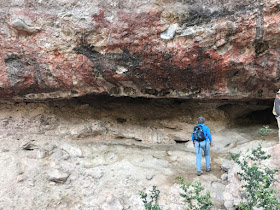We were now camping comfortably at a remote rancho on the floor of Arroyo San Gregorio in central Baja California. After an early breakfast (out of our tents before light) we hopped back on our mules to begin an exploration of the nearby caves. Surprisingly to me, I was not saddle sore from the previous days' 5-hour ride. These little mules seemed to have a gait that was simpatico with the trails. What a welcomed surprise this was.
We followed the stream bed through a paradise of cactus - cardon, cholla, pricky-pear, organ pipe - the list goes on. Everything was green beyond belief as a result of the recent rainfall. Onward the mules carried us through this verdant stream bed.
After about an hours' ride, we turned up into a side gulch and the mules trudged up a short but steep slope. And there we were at the mouth of a cave known as San Casimiro. Note that these features are referred to as 'caves' but technically a cave is a reentrant into a rock where natural light is lost completely. These were obviously not that deep and more correctly these are known as alcoves.
Our first view of some of the rock art. Notice the red, and black features on the alcove roof.
A closer view of some of the smaller elements found here.
Later in the morning we moved to an alcove called La Familia. This was one of the best rock art sites in the whole range. Larger elements were evident here and on the far left is a deer springing into action with anthropomorphs - human-like figures - just above the observers heads.
George admires a closer view of this panel. You can get a sense of the tremendous size of these figures.
Almost invariably throughout the Sierra San Francisco a bicolor pattern repeats itself with the black color being on the left (or bottom) and the red on the right (or top). In a only a few instances is this reversed. Our local guide mentioned that the two colors might represent day and night to the originators of the art. Of course, we will likely never know - the people who created these works of art are long gone. But rock art has become in recent decades an avenue of research to archaeologists and some things can be known.
These is not much material here than can give a clue as to where these people lived - there are no remnant structures of any kind within the alcoves. However, ground stones such as manos and metates are found and these were likely used to grind rocks to make the paint. (They could also have been used to grind seeds into meal). Our local guide found a reddish rhyolite rock that he quickly hammered into red powder. The black may have come from charcoal. Both colors would have mixed with fixative agents such as tree sap or pulp, urine, or other substances.
The proximity of the Sierra San Francisco to both the Pacific Ocean and the Sea of Cortez must have been important to the people who lived here as marine rock art elements are common. Two marine turtles (red) are seen next to a ray (black).
Depictions of baleen whales are also commonly seen in the rock art.
Like a shadow cast off from a fire onto a nearby wall, an anthropomorph appears to stare down at a strange unknown traveler from the future.
A close-up of the same element reveals a yellowish head cap. This may depict a feather headdress. Also, this is one of the rare instances where red is on the left and black on the right. Was this an outsider? A holy man or woman?
The old and the new! From left, Bryan, Chris, Orlando, Christine and George. What a great group of friends to share the experience with!
Bighorn sheep were also seen as elements on the walls in many caves. Today, the bighorn do not care to compete with the goat herds that graze here and thus have moved to the east to reside on the slopes and plains around the Tres Virgenes volcanoes.
A last look at the alcove of La Familia.
In the afternoon we walked to two other alcoves, San Gregorio 1 and San Gregorio 2. This is an upstream view of Arroyo San Gregorio from the first alcove.
Very large figures were found in this alcove.
And they were still very brightly colored. Of course, visitors want to know how old the rock art may be. There is no direct way to date the art but the material artifacts found in some of the alcoves give radiocarbon dates as old as 9,800 years, making them some of the oldest rock art examples in North America. Other dates from these alcoves suggest that some of the elements are as young as 3,000 years.
Birds and rabbits (or anterless deer) are depicted here.
Stunning rock art in Arroyo San Gregorio.
George admires a very large baleen whale on the roof of San Gregorio 2. This would be our last night camping near Rancho San Gregorio and the next day we would be on our way to Arroyo Santa Teresa to the west.





















No comments:
Post a Comment
If your comment will not post, email me with the problem.